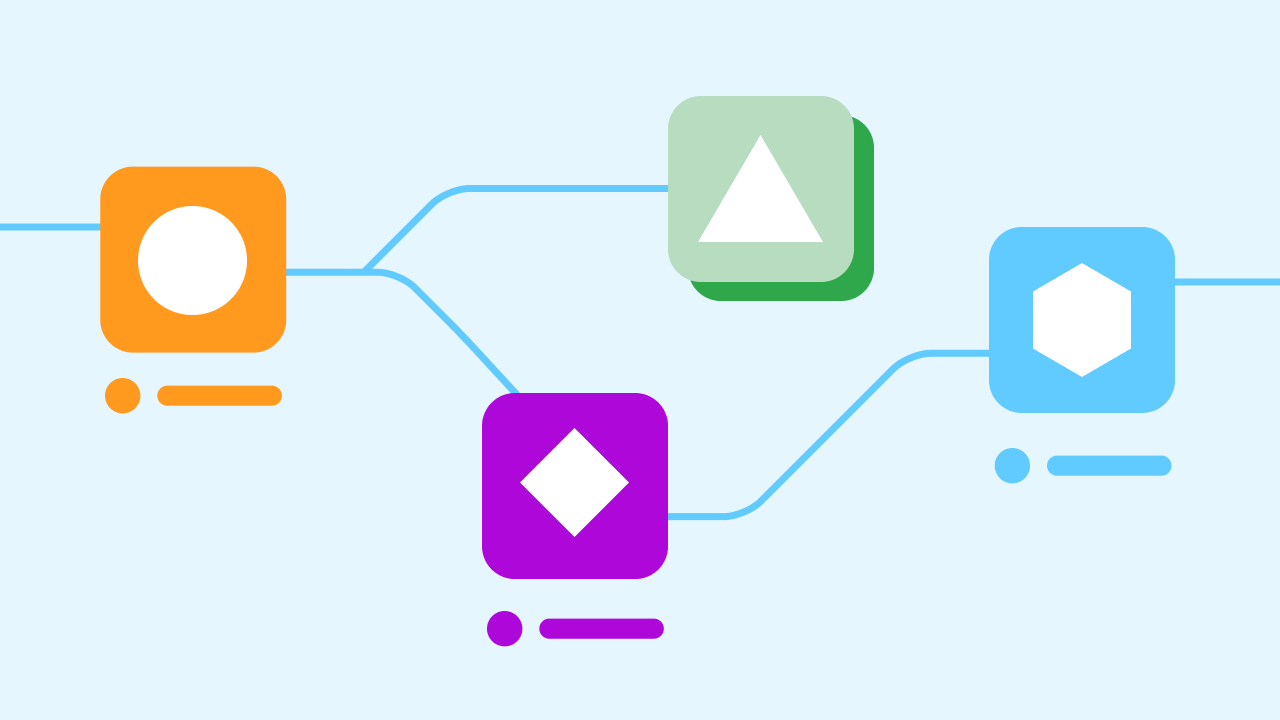Many prioritization models — reasonably — focus on nitty-gritty details like features, functionality, feasibility, tech specs, and so on.
The only problem: That approach can sometimes overlook the forest for the trees.
User story mapping is a prioritization technique that allows you to keep the big picture in mind the entire time by sorting features based on how they fit into the overall user journey.
In this article, we’ll dive into:
- What user story maps are
- How user story mapping works
- The key benefits of user story mapping
- Who user story mapping is best for
And if it turns out that user story mapping isn’t right for your team, there are plenty of other models you can try. Check out our guide to the best product management prioritization frameworks and see which ones make the most sense for your team.
What is user story mapping?
User story mapping (sometimes called “user journey mapping”) is a way to prioritize features based on user experiences. It’s a popular framework for agile teams, as it allows you to organize features within themes, epics, releases, and sprints.
With a user story map, your team’s goal is to understand how your customers are using your product — or how they’d like to.
- What are their goals?
- What are the main tasks they’re trying to complete?
- How do they interact with your product along the way?
From there, you can create a chart — with layers of increasing detail — outlining the steps needed for those goals and the features needed for each of those steps. It provides a visual representation of a user's perspective in your app. This way, you can easily spot gaps and dependencies and prioritize the highest-value, most necessary features first.
Compared to other prioritization frameworks, user story mapping is pretty unique. For one, it doesn’t sort features into categories at all. Instead, it sorts features into the journeys that users take within your app.
In this way, user story mapping helps you focus on the bigger picture and the overall UX of your product, not just individual features or functions.
PSA: The Jobs to Be Done framework and the Kano model can make good complements to user story mapping.
How does user story mapping work?
User story mapping works by helping you prioritize features based on how they fit into the actual flow of user experiences. This way, you can focus the product development process on the features that are most critical for — and can most enhance — those experiences.
The idea can be a bit tricky to visualize, but the idea is to think about all functionality and interactions from a user perspective. The goal is to end with a map that shows a user’s entire journey to complete a task in your product, and to understand exactly which features are needed for that journey.
Here’s how it works:
1. First, you’ll identify the core journeys (or stories) that users will take with your product. The user story format is:
As a [type of user], I want to [task or action] so that [goal or benefit].
A few examples that might be relevant for workplace communication software:
- As a [busy CEO], I want to [get automatic status updates] so that [I don’t have to bother my staff so much].
- As a [manager], I want to [notify my team members about upcoming work] so that [everyone stays on the same page].
- As a [junior-level employee], I want to [be able to reach my boss quickly with questions] so that [I can accomplish my work with fewer backlogs].
2. With these core goals or user stories in mind, you can then break down each step of every user journey. Many teams like to do this in a tactile way, with sticky notes on a giant poster board, for example. You can also use an online software like Miro or Figma.
Each step of the user journey should be a box or a sticky note across the top of your map.
For example, for this journey:
As a [manager], I want to [notify my team members about upcoming work] so that [everyone stays on the same page].
Your boxes might be:
- Add a new task to my team’s calendar.
- Assign a new task to a team member.
- Set notification for task assignment.
3. With your user journey mapped out, you’ll then want to list the tasks, steps, or features needed to accomplish each step in the process. Put each of these on an individual sticky note or box in columns beneath each step in the journey.
For example, for the step “Add new task to my team’s calendar,” you might have the following sub-tasks or features:
- Team calendar view
- Workspace teams
- Add workspace members to teams
- Add tasks to calendar
- Task view with details
Once you’ve added the relevant features for each step, you can sort product features so that the highest-priority ones are at the top of the column. In this example, you’d need to have workspace teams and task views built before you could add new tasks or sort members into teams.
Once you’ve gone through these steps, you’ll have your user story map in place.
Relevant features for user journeys are sorted by stage of the journey and priority. This helps your team understand user experiences, identify feature gaps, prioritize high-value features for customer experiences, and build your roadmap for upcoming sprints or product releases.
You can focus on as many or as few user stories and core journeys at a time. However, we recommend keeping it to three or fewer so that it’s easier to prioritize features to your roadmap and make meaningful progress.
What are the benefits of user story mapping?
User story mapping is a unique prioritization framework that offers a lot of benefits. For example:
- It centers user experiences and value. By envisioning the entire user story and not just individual features or ideas, you can better prioritize the user experience in your product development.
- It’s a more visual way to prioritize work. User story mapping is a great framework for collaborative prioritization. Visual diagrams make prioritization clear and help your team come to a shared understanding faster.
- It’s great for prioritizing your backlog. If you’re working within an agile development framework, user story mapping is a great way to visualize and provide context for your backlog. This helps you better understand the big picture and prioritize backlog tasks efficiently.
- It helps you deliver value to customers at every stage. By sorting features by story maps, you can more easily understand the big picture of how all your features fit together for the user. As a result, you can drive more value, faster, to your customers and iterate more easily on the customer experience.
User story mapping templates
A template can be helpful for visualizing how your user story map should look. Notice how there’s big boxes in the top row for the main steps of each journey, followed by smaller pieces of each step, and then individual features in the columns below.
When should you use user story mapping?
User story mapping is especially useful within agile development frameworks, since it centers the customer and fits well within the themes, epics, sprints, and releases frameworks of agile development.
User story mapping is also designed to be a very collaborative exercise. As such, it’s a great choice for cross-functional teams who need or want to include lots of stakeholders in the prioritization process.
Any team that has a role in shaping the customer experience can play a role in user story mapping, including your development team, UX, design teams, product management, sales teams, marketing teams, customer support, and more.
In short, you should try user story mapping if:
- You want to center user experience when prioritizing features
- You're working within an agile framework
- You have a large, cross-functional team who needs to be involved
- You have a large backlog to prioritize
Keep in mind that user story mapping only works when you truly understand user goals, activities, and experiences.
After all, if you don’t know your customer journey, it’s pretty hard to create an accurate map!
So be sure to carefully interview, understand, and connect with your target audience or customers before you dive into user story mapping to make sure you’re building for the goals and actions that your customers really want.
Implementing user story maps
Once you have your user story map and product roadmap in place, you’re ready to start building features and launching your product!
As you build, you’ll find that your story map remains a work-in-progress as well, just like your product itself. You may discover that certain features need to be re-prioritized, adjusted for feasibility or development resources, or iterated based on new customer feedback or user journeys.
You may even want to build regular time into your product management timeline to review your user story map and adjust for new releases and current focuses.
Of course, adjusting a roadmap or prioritization framework is simple enough. Adjusting your development and product to keep up with new changes is a bit harder.
No-code tools like Bubble make this so much easier.
With Bubble, you can build your entire product — from MVP or V1 through all your iterations and releases — in a single, full-stack development platform that lets you launch and learn quickly. Get more feedback from your customers, faster; iterate quickly; and build the features your customers want and need without the long development timeline.
So what are you waiting for?
Build your app on Bubble's Free plan. No need to upgrade until you're ready to launch your app.
Join Bubble




